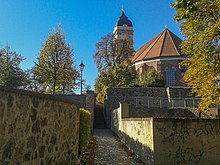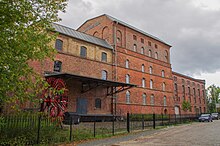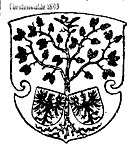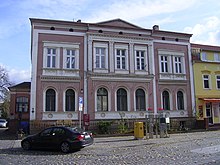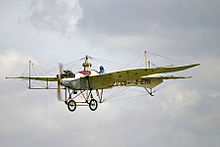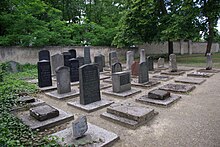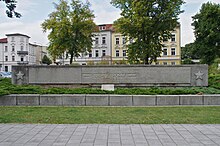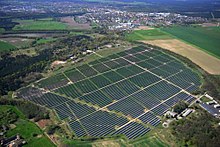Fürstenwalde / Spree
| coat of arms | Germany map | |
|---|---|---|

|
Coordinates: 52 ° 22 ' N , 14 ° 4' E |
|
| Basic data | ||
| State : | Brandenburg | |
| County : | Oder-Spree | |
| Height : | 43 m above sea level NHN | |
| Area : | 70.68 km 2 | |
| Residents: | 31,965 (Dec. 31, 2019) | |
| Population density : | 452 inhabitants per km 2 | |
| Postal code : | 15517 | |
| Area code : | 03361 | |
| License plate : | LOS, BSK, EH, FW | |
| Community key : | 12 0 67 144 | |
| LOCODE : | DE FTE | |
| City structure: | Core city and 3 districts | |
City administration address : |
Am Markt 4 15517 Fürstenwalde / Spree |
|
| Website : | ||
| Mayor : | Matthias Rudolph (BFZ) | |
| Location of the city of Fürstenwalde / Spree in the Oder-Spree district | ||
Fürstenwalde / Spree ( ˈfʏʁstn̩ˌvaldə ) is the most populous city in the Oder-Spree district in the east of Brandenburg . It is an important administrative and economic center.
St. Mary's Cathedral is the landmark in the city center. Since the end of 2013, the city has had the official addition of the name Domstadt to his honor . Another name that is steeped in tradition is the Green City on the Spree , which refers to the abundance of forests all around and the tall trees within the city.
geography
location
Fürstenwalde is located about 50 kilometers east-southeast of Berlin and about 30 kilometers west of the city of Frankfurt (Oder) . It is just under 20 kilometers to the city of Müncheberg in the north and around 25 kilometers to the district town of Beeskow in the south-southeast. The closest town is Storkow (Mark) , about 14 km southwest of Fürstenwalde.
The Berlin – Frankfurt (Oder) railway line , the (Fürstenwalder) Spree as part of the Spree-Oder waterway and the 12 Berliner Ring -Frankfurt (Oder) motorway run through the city in an east-west direction .
geology
Fürstenwalde lies within the Berlin glacial valley , which the Spree flows through in this section . Fürstenwalde emerged at a narrow point in the valley, where it was comparatively easy to cross in the Middle Ages, as is typical for a city founded in a glacial valley.
To the south of the city the Rauener Mountains rise quite prominently ; to the north is the basic moraine area of Lebus .
Neighboring communities
Fürstenwalde borders the following communities (clockwise, starting from the north): The districts Jänickendorf, Beerfelde, Buchholz and Neuendorf im Sande of the community Steinhöfel , Berkenbrück , Langewahl , the Bad Saarow district Petersdorf, Rauen , the districts Markgrafpieske and Braunsdorf of the community Spreenhagen as well the Grünheid district of Hangelsberg.
City structure
The city of Fürstenwalde is divided into the three districts center , north and south . The Berlin-Frankfurt (Oder) railway line represents the border between the Mitte and Nord districts and the Spree represents the border between the Mitte and Süd districts.
The districts of Heideland , Molkenberg and Trebus also belong to the city.
Other residential areas outside the city center are Expansion East , Buschgarten , Fürstenwalde South , Fürstenwalde Southwest , Große Tränke , Kleine Heide , Laubenkolonie Nordost , Onkel-Toms-Hütte , Palmnicken , Waldrandsiedlung and vineyards .
history
Naming
The name Fürstenwalde is derived from a princely founding in a forest area , the approach used in GDR times to derive the name from the location of the city at a ford in the forest cannot be historically proven.
In the first years of the GDR in 1950/51, as part of the elimination of feudal traditions, a renaming of the city to Spreestadt or Spreewalde was discussed, but the GDR Interior Ministry did not approve this.
Prehistory and founding of the city
As early as the 1st century there is said to have been a settlement called Susudata in the area of today's Fürstenwald .
The first documentary mention of Fürstenwald was in 1272 (as Furstenwalde ), but the city is likely to have been founded between 1225 and 1250. The founding of the city was favored by its location on a ford through the Spree. The city was laid out with a regulated road network, which has largely been preserved to this day. A few hundred meters down the Spree there is the old town , the name of which points to a (probably Slavic ) predecessor settlement. The designation has been preserved in some street names to this day.
It owes the city's rise to one of the wealthiest in the Mark Brandenburg to the fact that the Spree was no longer navigable to the east from here. The goods to and from the next waterway, the Oder , were brought by land. Since Fürstenwalde the settlement rights owned dealers were obliged to offer the goods on the spot before they were handled and transported.
The wrong Woldemar
Fürstenwalde played an important role in the disputes over the false Woldemar . In 1348 the false Woldemar moved into the march and tried to win the cities over. The Bishop of Lebus spoke out for Woldemar. Several cities, including Fürstenwalde, opposed the bishop and continued to support the Wittelsbach margrave Ludwig . In the following arguments, Ludwig's supporters got the short straw. Fürstenwalde then had to make “considerable deliveries” to Woldemar. At the end of October 1348 Ludwig captured Fürstenwalde again and confirmed the town's old rights and privileges.
Fürstenwalde becomes a bishopric
In 1373, Emperor Charles IV acquired Brandenburg from the Wittelsbachers in the Treaty of Fürstenwalde for compensation of 500,000 guilders. When he entered the Mark, his troops had also destroyed the episcopal residence and the collegiate church of Lebus . The hastily convened chapter meeting decided to make the well fortified and rich city of Fürstenwalde the seat of the Lebus diocese . From 1385 on, Fürstenwalde belonged to the three historic cathedral cities and bishoprics of Brandenburg, along with the cities of Brandenburg an der Havel and Havelberg , following confirmation by the Pope .
After the pillage by the Hussites in April 1432, the reconstruction of St. Mary's Cathedral began in 1446 in its current form. With its 68 meter high tower, it is one of the prominent landmarks of Fürstenwald. The Fürstenwalde town hall also dates from this time . As a result of the reformation of the Mark Brandenburg, the diocese was secularized at the end of the 16th century . In 1557 the cathedral was given to the Lutheran congregation.
Development after 1600
In 1624 the town hall tower was added and the town fortifications renewed. Fürstenwalde has enjoyed a good reputation as a school town since the Middle Ages. In the plague years of 1613, 1625 and 1656, the Viadrina University was relocated here from nearby Frankfurt (Oder) .
With the construction of the Friedrich Wilhelm Canal between 1662 and 1669, which connected the Oder with the Spree, the importance of Fürstenwald as a trading and goods transshipment point decreased. Nevertheless, the city's water connection to Berlin and the North and Baltic Seas was an argument for settling.
Industrialization and urban growth
With the construction of the Spreemühlen in 1837 and the resulting quantities of goods, the city experienced another economic boom. This is one of the reasons why the city was connected to the Lower Silesian-Märkische Eisenbahn - one of the first German railway lines - in 1842 . The Fürstenwalde (Spree) Bahnhof exists today and one of the oldest railway station in Germany.
Local craft flourished in the 19th century and was the cradle of the industrial structures that still exist today in a diverse mix of industries (for example, the Henry Hall iron foundry). Fürstenwalde finally became an industrial city when the Berlin company Pintsch moved a large part of its production facilities to Fürstenwalde in 1872. During the Second World War , the company expanded into an arms factory with around 12,000 employees (including many forced laborers and prisoners of war).
Due to the strong increase in population, the city first grew to the railway line running north of the city and in the 20th century beyond. South of the city, across the Spree, lies Ketschendorf (today Fürstenwalde Süd ). Due to administrative circumstances - Ketschendorf was in a different district as well as in a different administrative district - an independent development took place here. The largest company here was Deutsche Kabelwerke , from which the Pneumant tire factory later developed. Both places grew together over time, so that the former city limits on Rauener Strasse can no longer be seen today.
Period of National Socialism and the post-war period
At the beginning of the Nazi era , the political opponents of the Nazis were imprisoned and tortured in the Fürstenwalder Hof at Gartenstrasse 41, today's Kulturhaus, until they were transferred to the early Oranienburg concentration camp. During the November pogroms in 1938 , the synagogue of the Jewish community at Frankfurter Strasse 96 was destroyed. The Jewish cemetery also fell victim to the pogrom. During the Second World War, the first subcamp of the Buchenwald concentration camp was set up in 1943 at Lindenstrasse 31 for up to 90 prisoners. In 1944, the prisoners were transferred to Ketschendorf where since 1942 a satellite camp of Sachsenhausen concentration camp was built for 900 prisoners, who for the German Ausrüstungswerke the SS were used for the construction of fortifications and bunkers. Their camp was surrounded by barbed wire charged with high voltage. Atrocities and shootings were the order of the day. Shortly before the end of the Second World War, the German city commandant declared Fürstenwalde a fortress, and the city was reduced to rubble by bombing. The cathedral and town hall were also badly damaged and 80 percent of the residential buildings in the city center were razed to the ground.
In 1945, the Interior Ministry of the USSR (NKVD) set up the special camp Ketschendorf (special camp No. 5) in a workers' settlement of Deutsche Kabelwerke , which was occupied by up to 10,000 prisoners, including many young people suspected of the werewolf riot movement, of whom between 4,500 and 6,000 were not survived.
Redesign of the city center
The heavy destruction in the course of the Second World War mainly affected the central areas of the city, while the Wilhelminian expansion areas to the west and north of the medieval city area were largely preserved. In addition to rebuilding and closing gaps, several large new building areas have been built in the city center since the 1950s. They are a reflection of the prevailing ideas of modern urban design. To the east of Mühlenstrasse, many new prefabricated buildings were built in the late 1980s , for which various remaining buildings were demolished.
In the 1950s and 1960s, many buildings were restored and new residential areas emerged. Fürstenwalde developed into an important industrial location in the region with the Pneumant tire factory and the chemical and tank system construction "Ottomar Geschke" as the most important companies.
New roads or road widening partly led to the reshaping of the historically evolved urban form. So the barely destroyed Rosenviertel with the so-called Fürstenwalder Hosenbein disappeared for a street breakthrough (today the southern end of Eisenbahnstraße). The pant leg was a branching off of several alleys and a landmark of the city. Furthermore, the Wassergasse and the eastern end of the Schloßstraße were greatly widened and developed into a continuous three-lane street. To this day, there are undesigned and abandoned areas in the historic city center.
Since the 1990s, after the political change , various formative new buildings have been built in the center. The administrative building of the Kreissparkasse next to the Bullenturm on Goetheplatz was the first major post-war building. However, the political decision to move the headquarters of the Sparkasse Oder-Spree , which was newly created through the merger in 1994, to Eisenhüttenstadt resulted in part of the building remaining permanently unused (as of 2017).
In 1996 the town hall center was built on a large open area at the foot of the cathedral, which previously served as a park and market square . In the building, which includes a complete street block, there is a shopping center, offices and apartments as well as the Fürstenwald city administration. This was previously housed in different buildings in the city area. In the same year the new Kaisereck was built on Ottomar-Geschke-Platz. The house, which houses shops and restaurants on the ground floor, is known as the Hotel Kaiserhof .
Another building block was the Prince's Gallery next to the Old Town Hall. This building complex includes shops, apartments, offices and the district court . With this, and with the construction of further buildings, the structural connection between Eisenbahnstrasse as the city's main shopping street and the historic center around the market square was restored.
Fürstenwalde has been involved in the development of a program for sustainable urban development since 1998 and is involved in the Local Agenda 21 network . On September 23, 2008 the city received the title Place of Diversity awarded by the federal government .
Military in Fürstenwalde
For a long time, the military shaped the cityscape. Previously it was the troops of Napoleon and the Uhlan regiments of the German emperors, until 1994 troops of the group of the Soviet armed forces in Germany (from 1991: western group of troops ) were stationed in and around Fürstenwalde. The NVA built the Fuchsbau bunker south of the city. In the 21st century, Fürstenwalde no longer has any military locations.
Due to the numerous barracks, there are many new uses in the course of the conversion : The barracks complexes Neue Gartenstrasse , Rudolf-Breitscheid-Strasse and the old town were converted into residential quarters. The Berkenbrücker Chaussee , Külzstraße and Waldfrieden locations became forest and green areas. Other sites are used as commercial and industrial sites, including a. Langewahler Strasse and Pioneer Park . Not all buildings have been re-used to this day, so they are in a partially ruinous condition.
Administrative structures
Since the district reform of 1816, Fürstenwalde has belonged to the Lebus district of the Prussian administrative district of Frankfurt in the province of Brandenburg .
1950 Fürstenwalde the county seat of the newly formed of the same circle , consisting essentially of the then district Beeskow-Storkow was formed and since 1952 part of the District of Frankfurt (Oder) was.
In a series of administrative reforms in the early GDR, the layout of the municipality was changed: After Fürstenwalde, the Rauensche brickworks were incorporated into Fürstenwalde-Südwest and Ketschendorf on July 1, 1950 . Ketschendorf and the Fürstenwalder Spreevorstadt and Westend became the southern district . The district of Fürstenwalde West was again reclassified to Hangelsberg .
The last major changes took place in 1993. In that year, the northern part of Trebus was incorporated as a district. Furstenwalde also came to the newly formed Oder-Spree district through a district reform . The reorganization was connected with the loss of the district town status. Fürstenwalde has been the most populous city in the district since 2008. It is a medium-sized center and an important administrative and business location.
In the municipal reform of 2003 , no places were incorporated into Fürstenwalde. In 2015 Molkenberg became the second district of the city. The settlement around the former estate in the north of the city did not previously have an independent status. The youngest district, since 2016, has been Heideland , an area west of the city.
Population development
|
|
|
|
|
Territory of the respective year, number of inhabitants: as of December 31 (from 1991), from 2011 based on the 2011 census
politics
City Council
The city council of Fürstenwalde consists of 32 city councilors and the full-time mayor.
| Party / group of voters | Seats 2014 | Seats 2019 |
|---|---|---|
| Fürstenwalder Zukunft alliance | 5 | 7th |
| AfD | 2 | 5 |
| CDU | 6th | 5 |
| LEFT | 7th | 5 |
| SPD | 6th | 4th |
| GREEN | 2 | 3 |
| FDP | 3 | 2 |
| The party | - | 1 |
| PIRATES | 1 | - |
| All in all | 32 | 32 |
mayor
- 1990-2010: Manfred Reim ( FDP )
- 2010–2018: Hans-Ulrich Hengst (independent)
- since 2018: Matthias Rudolph (Bündnis Fürstenwalder Zukunft - BFZ)
Rudolph was elected for a term of eight years on February 25, 2018 with 52.2% of the valid votes. His term began on May 7, 2018.
Member of the state parliament
In the sixth Brandenburg Landtag , the Landtag constituency Oder-Spree III , to which Fürstenwalde belongs, is represented by the directly elected MP Elisabeth Alter ( SPD ). In addition, the members of the state parliament Volkmar Schöneburg ( Die Linke ) and Dierk Homeyer ( CDU ) have their citizens' offices in Fürstenwalde.
coat of arms
The coat of arms was approved on February 11, 1998.
Blazon : “In silver, a rooted green deciduous tree with a black raven flying up to the left in the crown; the trunk is surrounded by two shields, in front in gold a red-armored and red-tongued black eagle, covered with a soaring silver crescent, the cavity of which is decorated with a cross; behind in silver a gold-armored red eagle with golden clover stems on the wings. "
The basic type of the coat of arms has been preserved for centuries. The tree stands as a symbol for the wealth of forests in the area. The two shields arranged on the trunk, showing the Silesian and Brandenburg eagles , point to the city's eventful history. This could also be seen as a reference to the city's centuries-old border location. The bird that flies up was last interpreted as a raven . Today the raven has become the city's mascot.
Town twinning
Fürstenwalde maintains city partnerships with the following cities:
Furthermore friendship agreements were signed with:
name suffix
At the initiative of the cathedral pastor Martin Haupt, the addition of the name cathedral city was discussed in the Fürstenwalder city council in 2013 . The name Goßmannstadt (after Gerhard Goßmann ) was also mentioned as a counter-proposal that could not be won by a majority . Because no majority could be found, it was decided to let the Fürstenwalder population vote on the addition of the cathedral city parallel to the 2013 federal election . 51.8% of those eligible to vote in Fürstenwalde took part in the vote. 65.1% of them voted for the proposal. Following this vote, the city council for Fürstenwalde unanimously decided to add the name cathedral city . However, it is not official and therefore does not have to be used.
Sights and culture
Buildings
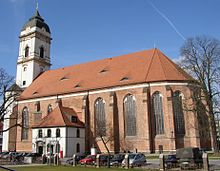
with the monuments entered in the list of monuments of the state of Brandenburg
Evangelical Cathedral of St. Mary
After the previous church had been destroyed, the St. Mary's Cathedral was built in 1446 as a late Gothic brick building, which later received a tower and extensions in the Baroque style. The interior is dominated by a 12.5 meter high late Gothic tabernacle from 1517. Towards the end of the Second World War , the cathedral was almost completely destroyed. The community was able to consecrate the new building in 1995.
Other sacred buildings
- The Evangelical Lutheran Church is a towerless neo-Gothic brick building from 1883. It is the only church in the city that was not destroyed in the Second World War. The ensemble of buildings on Dr.-Wilhelm-Külz-Straße consisting of the church and the rectory is a listed building.
- The Catholic parish church of St. Johannes Baptist on Seilerplatz is a neo-Gothic brick building, built between 1905 and 1906 according to plans by Engelbert Seibertz , consecrated in 1906.
- The Martin Luther Church in the south district was built in 1910 as a Ketschendorfer village church in neo-Gothic style. It is located on Schillerstrasse.
- The church of the Samariteranstalten on August-Bebel-Straße was built as a neo-Gothic brick building in 1925.
- The village church in the Trebus district , originally a medieval stone building with a tower, was replaced by a baroque building in the 18th century. In 1945 it burned down and was rebuilt from 1953 to 1955.
Secular buildings
The Gothic old town hall from the 16th century was rebuilt after the war damage suffered in 1945. The preserved town houses in the historic center - often half-timbered houses in Baroque style - are worth seeing, including the narrowest house from the 17th century and the weavers' houses from the 18th century.
On the corner of Mühlenstrasse and Schloßstrasse there was a brewery from 1777 to 1936. The wooden gallery in the courtyard is remarkable, the last of its kind in the city. In this building from the 18th century, the descendants of Ludwig Mord now run a private museum on the history of the Ludwig Mord beverage store and a restaurant with a beer garden.
The episcopal palace was built in the 14th century for the Lubusz bishops . After a fire in the 16th century, only a castle-like part remained, which is why it was popularly known as the bishop's castle . It was given its present form in 1891 and 1905. Between 2011 and 2013 it was restored and prepared for residential and commercial use.
Other remains of the bishop's palace were demolished and a brick building was rebuilt in 1850. This was used commercially (brewery, margarine factory, department store). The plant suffered severe damage in World War II. Until 1990 it was used as a warehouse and administrative center. With the founding of the cultural association, a new use as a culture factory was found. It offers space for many clubs.
The hunting lodge , 1699/1700 under Elector Friedrich III. Erected by court architect Martin Grünberg in simple baroque forms, it was converted into a granary for the military from 1750 under King Friedrich II . In 1795 it was given another granary next to it. Military use ended with the Second World War and the castle served as a warehouse until 1993. Since then it has been empty and decayed. In September 2013 the castle was auctioned by the city of Fürstenwalde, which is trying to find a new use.
Other buildings and ensembles of buildings that are worth seeing are the cathedral school from the 19th century, the Uhlan barracks of the 3rd Uhlan regiment from 1894, which now serves as a residential building, the boys' school from 1891, the Lässig villa , a building from the Wilhelminian era , remains of the city fortifications with bull tower and defeat gate as well as the Grasnick fountain in Eisenbahnstraße.
Museums
In the Fürstenwalde Museum at Domplatz 7 , 10,000 years of geological, prehistory and early history are presented. With the "Bennholdsche sediment collection" it houses one of the largest sediment collections in Europe. In addition, over 700 years of city history as a bishop, border, trade and industrial city are illustrated.
In the Bürgerpark am Dom there is a rock garden, which was opened in 2011 and based on an idea by geologist Dr. Harro Hess shows 17 selected erratic boulders from the Rauenschen Mountains and the Welzow-Süd opencast mine . The information board not only describes the different types of boulders, but also provides information about Walter Bennhold (1876–1952) and the Ice Age Trail.
At the turn of the 20th to the 21st century there was an ABM company "Historischer Flugzeugbau" at Fürstenwalde airfield , to which an aircraft museum was affiliated. The pride of the company was an airworthy replica of the Etrich Taube , which u. a. could be seen at the ILA 2004 .
Between 2011 and 2014, extensive renovation and conversion work took place on the old town hall (Am Markt 1) . A brewery museum with a modern show brewery was set up in the basement , reminding of the long brewing tradition in Fürstenwalde.
A privately run museum with a similar theme is located in “Mord's Eck” (Mühlenstrasse 17 / corner of Schloßstrasse) . Here, in a building steeped in tradition, exhibits of the cooper's trade , schnapps production and beverage bottling are presented.
Memorial sites
Former Jewish community
The synagogue, which was destroyed in 1938, is commemorated by a plaque on the front of the residential building at Frankfurter Straße 96 . A few steps further, on the corner of Frankfurter Strasse and Grünstrasse , a plaque commemorates the Jewish cemetery, which was also destroyed in 1938, with its mourning hall, which was built in 1928.
Victims of fascism and stalinism
A memorial was erected on Ottomar-Geschke-Platz in 1977/78 for the victims of fascism . The memorial at August-Bebel-Strasse 62 is dedicated to the anti-fascist resistance fighters .
In 1995, a memorial grove with a memorial stone for the victims of was NKVD - internment Ketschendorf southwest of Beeskower road built.
Parks and green spaces
The city of Fürstenwalde is almost completely surrounded by forests, only in the north there are larger arable areas. The green extends over the city park and the Spree embankment right up to the historic center. Because of its high population of trees and many smaller and larger green areas, the city has had the unofficial nickname "Green City on the Spree" since the 1920s.
city Park
The city park is located in the west of the Fürstenwald. It was created from 1836 by the councilor Christian Friedrich Schultze. Initially only located on the banks of the Spree, it was expanded until the railway line opened in 1842 . Today's Dr.-Wilhelm-Külz-Straße crosses the park and divides it into the older part to the south and the much larger newer part in the north. The shore were small gardens built went whereby the Spree reference lost. In the eastern part of the park there is a larger open space, the former Wilhelmplatz. After the wars of unification, several peace oaks were planted here, which still exist today. At the western end of the square, a memorial grove for fallen Red Army officers was created after the Second World War . The central point of the city park is the fountain on the Großer Stern, built in 1939.
At Dr.-Wilhelm-Külz-Str. is the park stage opened in 1955. This is used regularly from May to September as an open-air stage for concerts, movies and events. In 1975, in the northwest, an area of the city park was converted into the Fürstenwalde home zoo. Today more than 300 animals from around 70 mainly European species live here. Immediately adjacent is the fairground of the city, which is used for Rummel- and circus events.
Opposite the pet garden is the park club of the Fürstenwalde culture factory. In addition to its own DIY workshop, this offers events, concerts of various musical styles and a bar.
Spreeuferpark
In the course of Fürstenwald's application, the bank of the Spree between the Stadtpark and the Spreebrücke should become part of the 2004/06 state horticultural show under the motto Old Town on New Shores . After the show in Rathenow was awarded, a considerable part of the planning was implemented and officially opened as a park-like facility on June 1, 2007. The central component is the continuous promenade as part of the Spree Cycle Path . The scenic riverside area with relaxation areas, themed gardens and sunbathing lawns is also used for parties. The Goetheplatz is located near the large Spreewiese , a former Schützenplatz, which stands out due to its very old tree population. The 2012 completed Martini Garden, named after a former Fürstenwalder City Council, provides the connection of the riparian zone on Karl Marx Street to Station ago.
Park of the Seasons
The approximately 30,000 m² park of the seasons was built on the area of the former churchyard . After the graves were cleared in the 1980s, the area was built on with a few old people's homes , but was not redesigned afterwards. Between summer 2009 and spring 2010, the entire area was redesigned, with the main theme being chosen in analogy to the course of a person's life.
Other plants
To the east of the cathedral , the Bürgergarten , including the outdoor facilities of the culture factory and the museum, as well as remnants of the old city fortifications, was laid out. The village green of Ketschendorf on August-Bebel-Strasse has been preserved .
The Mühlenberg , an elevation designed as a playground, is located in the north district . In the area of the former hospital, the district park Kleine Freizeit was built in 2012/13 .
graveyards
The New Cemetery was laid out in the Westend south of the Spree at the beginning of the 20th century. It is the largest in the city and houses a war cemetery. Here was also Franz John , the first president of the football club FC Bayern Munich , buried. Another war cemetery is the forest cemetery on Hegelstrasse , which was laid out on May 5, 1945 for German soldiers who died of epidemics.
The Ketschendorfer Friedhof or Südfriedhof is located on Friedenstraße south of the motorway.
The Jewish cemetery is located near the Park of the Seasons . It was destroyed in the night of the pogrom and then lay fallow. It has now been tidied up and can be viewed after registration.
The districts of Rauensche Ziegelei (southwest) , Molkenberg and Trebus have their own cemeteries.
In 2006, an area of 45 hectares in the northwestern area of the Fürstenwalder Stadtwald was released as a cemetery for natural burials .
Culture
The Kulturfabrik , the socio-cultural center of the city, offers a home to many associations and initiatives in its rooms in the Bishop's Castle brewery complex. Founded by four associations, with the support of the city administration, a non-profit GmbH developed as a carrier. The city library can also be found here. Every year 60,000 visitors use u. a. the memorial library of the IG internment camp Ketschendorf.
In addition, the DomGalerie am Dom and the Union film theater invite you to visit. In addition to film screenings, readings also take place in the cinema.
The music and art school offers training in music and performing arts. The 1st Brandenburg Guard Brass Band Corps Fürstenwalde , created in 1990 through the merger of two orchestras, is particularly dedicated to the works of Brandenburg composers. Spiritual music is maintained by the members of the choir and children and youth choir of the evangelical St. Marien cathedral community as well as the choir of the Catholic parish church of St. Johannes Baptist.
The Con-brio Choir (which emerged from a youth choir in 1963, maintains German and European songs from different eras), the Fürstenwalde Chamber Choir and Chamber Orchestra and the Jazz Club operate under the umbrella of the Fürstenwalder Kulturverein . Other musical initiatives are the Park Club (formerly: Club im Park) , Joe's BigBand and the pop choir “The Golden Voices” .
Regular events
At the end of May, the Fürstenwalder City Festival invites you to the center of the city. June is marked by the zoo festival , dragon boat regatta and the two-day Highland Games , organized by the Fürstenwalder Highland Sports Club Stone Walker . At the end of August, the Stadtforst and the Club im Park invite you to Rock for the Forest . September offers the Samaritan Festival , the craftsmen's and farmers' market , the autumn zoo festival and the bicycle adventure day bike skirmishes . In October, not only the Fürstenwalder visit the medieval market . The Fürstenwalder Jazztage has been presenting these genres to international artists since 2002 . Since 2012, the Fürstenwalde Chamber Choir “Geschwister Scholl” has been organizing its series of concerts under the motto “History, Poems, Singing” every first weekend in November. The end of the event year is the traditional Christmas market at the cathedral during Advent.
Economy and Infrastructure
Industry
Fürstenwalde is one of 15 regional growth centers in the state of Brandenburg. In the manufacturing sector, there are companies from the automotive suppliers (including Dunlop tire factory , Pneumant Reifen GmbH Fürstenwalde ), energy (including E. DIS ), plastics & paints (including Deutsche Amphibolin-Werke , Baser Kunststoffe GmbH, SEDO Chemicals Neoprene GmbH) and metal processing ( including Reuther STC , Duktil Guss GmbH, RST Gesellschaft für Wasserspartechnik mbH). The housing construction company Bonava Germany (formerly Industriebau Fürstenwalde) and the manufacturer of energy storage technology deematrix Energiesysteme GmbH are based in Fürstenwalde.
traffic
Road traffic
Fürstenwalde is located on federal highway 168 between Müncheberg and Beeskow , which is largely developed as a bypass in the north and east of the city.
Several state roads have their starting point in the city: L 35 to Bad Saarow , L 36 to Markgrafpieske or Neuhardenberg , L 38 to Erkner or Briesen and L 361 to Storkow .
The city has two traffic bottlenecks: on the one hand, the Spreebrücke, which connects the districts center and south, on the other hand, the bridge over the railway tracks.
The A 12 Berlin – Frankfurt (Oder) runs directly south of the city with the junctions Fürstenwalde West and Fürstenwalde Ost . The A 10 (eastern Berlin Ring) can be reached via the Freienbrink junction .
Rail transport
The station Fürstenwalde is located on the route Berlin-Frankfurt (Oder) with maintenance of regional express trains on the line RE 1 Magdeburg -Berlin- Frankfurt (Oder) . Here the Fürstenwalde – Bad Saarow Klinikum branch branches off , on which the regional train line RB 35 operates. It is operated by the Niederbarnimer Railway . The Fürstenwalde Süd stop is also on this route.
Bus transport
The Oder-Spree bus service operates inner-city local transport with four lines. The tariffs of the Verkehrsverbund Berlin-Brandenburg (VBB) apply . The bus travel times are coordinated with the arrival and departure times of the trains to and from Berlin.
Line 411 runs from the north shopping center via Hegelstrasse to the train station (north branch). From the train station it leads over the city center, Spreebrücke, Lange Straße, Bahnhof Süd to Platz der Solidarität (south branch). Line 412 connects the station with the industrial park east. Line 413 strengthens the south branch of line 411 between the train station and Platz der Solidarität. It leads over August-Bebel-Straße. Finally, line 414 runs from the northern shopping center via Johann-Sebastian-Bach-Straße to the train station (north branch). In August 2019 it was extended to a burrow (south branch). It leads across the city center and Langewahler Strasse.
Air traffic
The Fürstenwalde airfield (EDAL) was located in the north of the city . This was given up in 2011 in favor of a large-scale solar power plant field.
shipping
The Spree-Oder waterway , a federal waterway from Berlin to the Oder , runs through Fürstenwalde . The Fürstenwalde lock is located in the village . Many tributaries of the Spree such as the Fürstenwalder Spree are used for tourism.
education
overview
Fürstenwalde is an educational location rich in tradition. In the years 1613, 1624, 1625 and 1656, the city was the alternative quarters for the Viadrina University from nearby Frankfurt (Oder) when the plague raged there.
Today there are six elementary schools , four high schools and two high schools in the city . There is also an upper level center with an attached vocational high school , three vocational schools and technical colleges , three special needs schools and eight further training institutions. The schools are run by the city of Fürstenwalde, the Oder-Spree district , the Archdiocese of Berlin and private sponsors. An important independent sponsor is the Rahn-Dittrich Group , which runs a primary school, a high school and a technical college with a focus on social affairs, economics and technology in Fürstenwalde.
Geschwister-Scholl-Gymnasium
The origins of today's Geschwister-Scholl-Gymnasium go back to the higher middle school founded in 1865 . The school changed its form several times ( Progymnasium , Vollgymnasium, Oberschule) and its location. The buildings at the current location at Frankfurter Straße 70 were erected at the end of the 1950s and the then secondary school moved into it in 1960.
In 1991 the grammar school, supported by the Fürstenwalde district , was established, which was given the name of the Scholl siblings in 1992 . With the reorganization of the Oder-Spree district, the sponsorship changed in 1993. Most recently, the outdoor facilities were redesigned in 2014 and 2015, including a small sports field. Further renovations were made in 2016 and 2017.
In 2007 the Werner-Seelenbinder-Gymnasium, which was also built in 1991 and supported by the city of Fürstenwalde, was integrated at Holzstrasse 1A . The school location on Holzstrasse dates back to 1893. The building was originally planned as a barracks, but was converted before the soldiers moved to the school. It has been expanded several times, most recently in the 1980s. In September 2006, the leisure and learning area “After-school-paradise” was inaugurated in the school environment. For many years the school had a partnership with a school in Gorzów (Poland) and had partnership relationships with two Indonesian schools.
Catholic school center
The only Catholic school center in the state of Brandenburg is the Bernhardinum (Catholic School Bernhardinum) at Trebuser Straße 45 . The Bernhardinum is privately owned by the Archdiocese of Berlin and consists of a primary school, secondary school and grammar school. The school has partnerships with schools in Poland, France, Italy and Sri Lanka.
Upper School Center Palmnicken
The Europaschule Oberstufenzentrum Palmnicken with over 3500 trainees and students is the largest educational institution in the Oder-Spree district. The facility combines courses from the vocational school, the vocational school, the technical college and the vocational high school. An essential focus of the educational work is the maintenance of diverse international relationships with partner schools in Japan, Sweden, France, Holland, Denmark and Poland, among others.
Beeskower Chaussee school center
Currently (2019) the Oder-Spree district is building a school center on Beeskower Chaussee, near the Fürstenwalde Süd train station. For this purpose, a secondary school is being built on the site of the former secondary school center, which is to replace the building on August-Bebel-Straße at the end of 2020. The secondary school is to be supplemented by a primary school part on the neighboring property of the former tax office.
Sports
A number of leisure facilities are concentrated in the north of the city, the most famous being the Schwapp leisure pool with a sports and fun pool and a sauna area. The Rudolf Harbig Stadium is also located here .
To the west of the city is the Friedrich-Friesen-Stadion , a sports complex consisting of several sports fields and facilities. On the main square, the Bonava-Arena , Fürstenwald's top-class football club FSV Union Fürstenwalde plays its home games. He plays in the Regionalliga Nordost in the 2019/20 season .
In the south of the city is the Pneumant-Sportforum , home of the BSG Pneumant Fürstenwalde , which is the second largest multi-discipline club in Brandenburg.
The year-round toboggan run Scharmützelbob is also located on the southern outskirts .
Personalities
Honorary citizen
- Wolfgang Kahl (* 1928), cathedral organist, for services in setting up the cathedral choir at St. Marien Cathedral , awarded in 1993
- Günter Kuhn (1928–2018), Superintendent , for services in the reconstruction of St. Mary's Cathedral, awarded in 1995
- Friedrich Stachat (* 1938), head of the socio-cultural center, for services in setting up the Fürstenwalder Kulturfabrik, awarded in 2003
- Eckhard Fichtmüller (* 1940), pastor, for services to the historical processing of the history of the internment camp Ketschendorf , awarded in 2015
Former honorary citizens
- Carl Arnold, master mason, inventor of the ring oven , awarded in 1873
- Richard Pintsch (1840–1919), co-owner of the formerly largest industrial company Julius Pintsch AG Berlin-Fürstenwalde, awarded in 1906
sons and daughters of the town
- Moritz Hofmann (1621–1698), physician, botanist and university professor
- Christian Mentzel (1622–1701), physician, botanist and sinologist
- Theodor Jacobs (1824–1893), member of the Reichstag
- Ernst Laas (1837–1885), educator and philosopher
- Paul Rehbach (1874–1934), politician, member of the state parliament in Württemberg
- Max Valentin (1875–1931), sculptor and architect
- Paul Henze (1880–1966), mechanical engineer and automobile pioneer
- Joachim-Friedrich von Owstien (1881–1970), lawyer, chairman of the Berlin Hereditary Health Court and President of the Senate of the Berlin Court of Appeal
- Ottomar Geschke (1882–1957), politician
- Wilhelm Burgdorf (1895–1945), General of the Infantry
- Wilhelm Heise (1897–1949), educator, literary scholar and university professor
- Arnold Krampe (1910–1983), administrative lawyer, district administrator and senior district director
- Ernst Diehl (1928–2004), historian
- Wolfgang Köpp (* 1933), writer
- Gerhard Wienckowski (1935–2011), painter and graphic artist
- Fred Klingauf (* 1936), phytomedicist and President of the Federal Biological Institute for Agriculture and Forestry
- Pit Kroke (1936–2016), visual artist
- Horst Lebinsky (* 1936), actor
- Wolfgang Götze (* 1937), theoretical physicist
- Hans-Joachim Jentsch (* 1937), politician (CDU), judge at the Federal Constitutional Court
- Hans-Michael Rehberg (1938–2017), actor and director
- Jürgen Schutte (1938–2018), literary scholar and professor of German studies
- Ludolf von Wartenberg (* 1941), politician (CDU)
- Claus Schreiner (* 1943), music journalist and producer
- Josefine von Krepl (* 1944), fashion designer and journalist, museum founder
- Helmut Panke (* 1946), manager
- Christine Grabe (1948–2016), politician (Alliance 90 / The Greens)
- Heinz Geisler (* 1950), rock musician and composer
- Barbara Zinn (* 1952), actress and radio play speaker
- Lothar Bölck (* 1953), cabaret artist
- Dan Radtke (* 1963), racing cyclist
- Burkhard Reich (* 1964), football player
- Christian Wegner (* 1979), founder of the re-commerce company momox
Personalities associated with Fürstenwalde
- Friedrich Stuhlmann (1410–1483), Bishop of the Diocese of Lebus and Chancellor of the Electorate of Brandenburg
- Dietrich von Bülow (1460–1523), bishop of the Lebus diocese, founder of the sacrament house in the Fürstenwald cathedral
- Tobias Quistorp (1616–1666), pastor in Fürstenwalde
- Christian Friedrich Schultze (1782–1845), “Heideherr” (forest manager) in Fürstenwalde, founder of the city park
- Karl Friedrich Schulz (1784–1850), Protestant hymn composer and music teacher
- Julius Pintsch (1815–1884), founder of the former largest industrial company in Fürstenwalde, Julius Pintsch AG Berlin-Fürstenwalde
- Franz John (1872–1952), co-founder of FC Bayern Munich and its first president from 1900 to 1903, was buried in Fürstenwalde
- Walter Dudek (1890–1976), politician (SPD), mayor of the city (1919–1922)
- Kurt Nadelmann (1900–1984), legal scholar at Harvard Law School , 1926–1928 judge at the Fürstenwalde District Court
- Gerhard Goßmann (1912–1994), graphic artist, book illustrator and painter, grew up in Fürstenwalde
- Sascha Lauterbach (* 1979), TV presenter, grew up in Fürstenwalde
- Axel Schulz (* 1968), boxer, grew up in Fürstenwalde
- Sven-David Müller (* 1969), medical journalist and nutrition expert, lives in Fürstenwalde
literature
- GFG Goltz: Diplomatic chronicle of the former residence town of the Lebusian bishops Fürstenwalde, from its construction up to the present time, with 14 lithographic sheets , Fürstenwalde ( e-copy ).
- W. Riehl and J. Scheu (eds.): Berlin and the Mark Brandenburg with the Margraviate Nieder-Lausitz in their history and in their present existence . Berlin 1861, pp. 373-376 ( online ).
- Heinrich Berghaus : Land book of the Mark Brandenburg and the Margraviate Nieder-Lausitz in the middle of the 19th century . Volume 3, 1st edition, Brandenburg 1856, pp. 185-196 ( online ).
- City of Fürstenwalde / Spree (Ed.): Fürstenwalder Reading Book: Above and below and turned x times . Democracy movements in Fürstenwalde from the Middle Ages to 1989. GVE-Verlag Berlin 2009, ISBN 978-3-89218-737-0
- Fürstenwalde. Then and now. Culturcon / Märkische Oderzeitung. 2011. ISBN 978-3-941092-78-5
- Ketschendorf (Spree). From the history of an industrial site (now Fürstenwalde / South). According to old documents and manuscripts recorded by Ernst Siebke, Vice-Rector i. R. Printing and publishing by Ph. Stephan Ketschendorf / Spree. 1935
Web links
- City website
- Kulturfabrik website
- Website of the Association for Local History and Local Lore Fürstenwalde / Spree
- historical view of the Grasnick fountain on zeno.org
Individual evidence
- ↑ Population in the State of Brandenburg according to municipalities, offices and municipalities not subject to official registration on December 31, 2019 (XLSX file; 223 KB) (updated official population figures) ( help on this ).
- ↑ a b Jeanette Bederke: Why Fürstenwalde now calls itself "Cathedral City" . In: Berliner Morgenpost . October 7, 2013 ( online ).
- ^ Service portal of the state administration Brandenburg. City of Fürstenwalde / Spree
- ↑ Duden - Geographical Names in Germany, Mannheim 1999, ISBN 3-411-06252-5 , p. 116.
- ↑ Wolfgang Bloß: Change and Names. Place name policy in Brandenburg 1945–1952 , in: Yearbook for the History of Central and Eastern Germany 2009, page 167, here page 217f; see also ADAC road map from 1951 .
- ^ Matthias Schulz: Google Earth in antiquity . In: Der Spiegel . No. 39 , 2010 ( online - September 27, 2010 ).
- ↑ Dr. Goltz: Diplomatic chronicle of the former residence town of the Lebusian bishops Fürstenwalde. Fürstenwalde 1837, pp. 24–35.
- ↑ City history. City of Fürstenwalde, accessed on July 26, 2018 .
- ^ Historical photo of the management level of Julius Pintsch AG Berlin-Fürstenwalde
- ^ Märkische Oderzeitung: Fürstenwalde largest city in the district
- ↑ Märkische Oderzeitung: Molkenberg is now a district
- ↑ Märkische Oderzeitung: Heideland becomes the third district
- ^ Meyers New Lexicon in eight volumes. VEB Bibliographisches Institut Leipzig, 1964/65. Vol. 3, p. 471.
- ^ Historical municipality register of the state of Brandenburg 1875 to 2005. Landkreis Oder-Spree . Pp. 14-17
- ↑ Population in the state of Brandenburg from 1991 to 2015 according to independent cities, districts and municipalities , Table 7
- ^ Office for Statistics Berlin-Brandenburg (Ed.): Statistical report AI 7, A II 3, A III 3. Population development and population status in the state of Brandenburg (respective editions of the month of December)
- ↑ Result of the local elections on May 25, 2014. Accessed on July 25, 2019 .
- ↑ Result of the local elections on May 26, 2019. Accessed on July 25, 2019 .
- ↑ Brandenburg Local Election Act, Section 74
- ^ Result of the mayoral election on February 25, 2018
- ↑ Coat of arms information on the service portal of the state administration of Brandenburg
- ↑ Entry in the monument database of the State of Brandenburg
- ↑ Museum Füstenwalde: permanent exhibition and rock garden
- ^ Nordkurier: Prost Fürstenwalde ( Memento from January 25, 2013 in the Internet Archive )
- ↑ Märkische Oderzeitung: Then a "Rathausbräu"
- ^ A b Anne Fellner and Jochen Rösler: "Fürstenwalde - The Green City on the Spree", Leipzig 2003, ISBN 3-934572-69-3
- ↑ Parkclub Fürstenwalde | Socio-cultural center. Accessed December 10, 2019 (German).
- ↑ Fürstenwalde to the Spree! ( Memento from February 11, 2013 in the web archive archive.today ), press release from the city of Fürstenwalde / Spree, May 2007.
- ↑ Park of the Seasons. City of Fürstenwalde / Spree, accessed on August 11, 2019 .
- ↑ Redesign of the former hospital site ( Memento from February 6, 2013 in the web archive archive.today )
- ↑ Homepage of the Volksbund Deutsche Kriegsgräberfürsorge: Fürstenwalde / Wald- und Neuer Friedhof , accessed on November 3, 2012
- ↑ The FriedWald Fürstenwalde. FriedWald GmbH, accessed on July 26, 2018 .
- ↑ Our school history. Geschwister-Scholl-Gymnasium, accessed on July 26, 2018 .
- ^ Start of the construction of a school center in Fürstenwalde. Oder-Spree district, accessed on August 10, 2019 .
- ^ Honorary citizen of Fürstenwalde
- ↑ The bookseller with the golden hand. In: Der Tagesspiegel , May 5, 2011
- ^ Biography Tobias Quistorp
- ↑ Honor for the founder of the Fürstenwalder Stadtpark Christian Friedrich Schultze. at www.fuerstenwalde-spree.de




